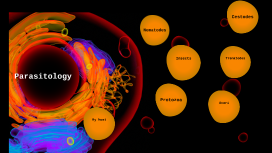parasitology
Transcript: Blastocystis Hominis Submitted by: Cheena Panganiban BS Biology IV-A Submitted to: Ms. Jenina Tongol •The classic form found in human stools is the cyst, which varies tremendously in size from 6 to 40 μm. • . The thick-walled cyst present in the stools • is believed to be responsible for external transmission, possibly by the fecal-oral route through ingestion of contaminated water or food • . The cysts infect epithelial cells of the digestive tract and multiply asexually ( , ). • Vacuolar forms of the parasite give origin to multi vacuolar •and ameboid forms. The multi-vacuolar develops into a pre-cyst •that gives origin to a thin-walled cyst , thought to be responsible for autoinfection. •The ameboid form gives origin to a pre-cyst , which develops into thick-walled cyst by schizogony . • Then thick-walled cyst is excreted in feces . GRANULAR FORM • Transmission is thought to be through fecal-oral route, much that like of other better known GI protozoa •Stool (fecal) exam •Endoscopy •Blood tests •Scans CYST FORM Classification •Blastocystis has various morphological forms. •Four commonly described forms are the vacuolar (otherwise known as central body), granular, amoeboid, and cyst forms. •. The appearance of the organism is largely dependent upon environmental conditions as it is extremely sensitive to oxygen. AMOEBOID FORM • Somewhat morphologically similar to the vacuolar forms except that distinct granules are observed in the central vacuole and / or cytoplasm. • 4 and 15 micrometers in diameter • Within the central vacuole, these granules appear in different forms too. -Metabolic granules play a role in chemical processes that are necessary for the maintenance of life in the organism. -Reproductive granules were involved in the development of progeny cells. •It has also been suggested that the granules may be an indication that the cell is dying. •This is a very rare form with irregularly shaped cells from 2.6 to 7.8 micrometers in diameter. •Pseudopodia are often attached. •A large central vacuole may or may not be present. •It has also been suggested that the granules may be an indication that the cell is dying. •Are produced only in cultures taken from symptomatic individuals. •This method could be used for diagnosing symptomatic infection. Causes • Many types of protozoa get into the intestinal tract through oral-fecal contact, such as occurs when a person doesn't wash his or her hands thoroughly after using the toilet before preparing food. •places with inadequate sanitation and poor personal hygiene. •worldwide in distribution, it is more common in less developed nations and may prefer tropical and sub-tropical climates Signs and Symptoms Morphology Public health and Prevention strategies Epidemiology Disease • Typical cell form of Blastocystis seen in culture and is often used for the identification of the organism. • Greatly in size, with diameters ranging between 2 µm and 200 µm. • The vacuolar form is otherwise known as central body form because it has a large central vacuole surrounded by a thin band of peripheral cytoplasm which contains other organelles. • asymptomatic individuals producing exclusively vacuolar forms. • The function of the vacuole is still unclear, however, it has been suggested that, like for many eukaryotic cells, it is for storage purposes. •is a genus of single-celled protozoan parasites •Blastocystis group of Stramenopiles – a vast array of organisms including brown algae, water molds, and diatoms. (also called Heterokonts) •living in the gastrointestinal tracts •A commensal which can become a pathogen •. It exhibits morphologic polymorphism consisting of a development cycle Test and Diagnosis Life cycle •A hard, resistive form between 6 and 40 micrometers in diameter. • A thick wall encapsulates the structure which includes many vacuoles and 1 or 2 nuclei. •has helped in the advancement of understanding the way the infection is transmitted •Generally smaller in size and has a thick multilayered cyst wall. •It lacks a central vacuole and few nuclei, multiple vacuoles •the most resistant form of this parasite and is able to survive in harsh conditions because of its thick multilayered cyst wall •Show its ability to withstand acidic gastric juices. Besides, the cysts did not lyse when placed in distilled water and could survive well at room temperature for up to 19 days, indicating its strong resistance. •The disease caused by Blastocystis Hominis, is referred to simply as Blastocystosis. •The original description of Blastocystis was as a yeast due to its yeast-like, This was then contradicted, it was reclassified as under subphylum Sporozoa, based on some distinctive protistan features of the Blastocystis cell, such as the presence of nuclei, smooth and rough endoplasmic reticulum, Golgi complex, and mitochondrion-like organelles •. An analysis of gene sequences was performed in 1996, which placed it into the group Stramenopiles and remains enigmatic History of

















